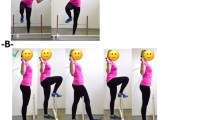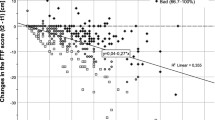Abstract
For an individual, the functional consequences of an episode of low back pain is a key measure of their clinical status. Self-reported disability measures are commonly used to capture this component of the back pain experience. In non-acute low back pain there is some uncertainty of the validity of this approach. It appears that self-reported assessment of disability and direct measurements of functional status are only moderately related. In this cross-sectional study, we investigated this relationship in a sample of 94 acute low back pain patients. Both self-reported disability and a performance-based assessment of disability were assessed, along with extensive profiling of patient characteristics. Scale consistency of the performance-based assessment was investigated using Cronbach’s alpha, the relationship between self-reported and performance-based assessment of disability was investigated using Pearson’s correlation. The relationship between clinical profile and each of the disability measures were examined using Pearson’s correlations and multivariate linear regression. Our results demonstrate that the battery of tests used are internally reliable (Cronbach’s alpha = 0.86). We found only moderate correlations between the two disability measures (r = 0.471, p < 0.001). Self-reported disability was significantly correlated with symptom distribution, medication use, physical well-being, pain intensity, depression, somatic distress and anxiety. The only significant correlations with the performance-based measure were symptom distribution, physical well-being and pain intensity. In the multivariate analyses no psychological measure made a significant unique contribution to the prediction of the performance-based measure, whereas depression made a unique contribution to the prediction of the self-reported measure. Our results suggest that self-reported and performance-based assessments of disability are influenced by different patient characteristics. In particular, it appears self-reported measures of disability are more influenced by the patient’s psychological status than performance-based measures of disability.
Similar content being viewed by others
References
Flores L, Gatchel RJ, Polatin PB (1997) Objectification of functional improvement after nonoperative care. Spine 22:1622–1633
Deyo RA, Battie M, Beurskens AJH, Bombardier C, Croft P, Koes B, Malmivaara A, Roland M, Von Korff M, Waddel G (1998) Outcome measures for low back pain research: a proposal for standardized use. Spine 23:2003–2013
Bombardier C (2000) Outcome assessments in the evaluation of treatment of spinal disorders: summary and general recommendations. Spine 25:3100–3103
Gatchel RJ, Turk DC (2008) Criticisms of the biopsychosocial model in spine care: creating and then attacking a straw person. Spine 33:2831–2836
Grotle M, Brox JI, Vollestad NK (2004) Concurrent comparison of responsiveness in pain and functional status measurements used for patients with low back pain. Spine 29:E492–E501
Verbunt JA, Westerterp KR, van der Heijden GJ, Seelen HA, Vlaeyen JW, Knottnerus JA (2001) Physical activity in daily life in patients with chronic low back pain. Arch Phys Med Rehabil 82:726–730
Verbunt JA, Sieben JM, Seelen HA, Vlaeyen JW, Bousema EJ, van der Heijden GJ, Knottnerus JA (2005) Decline in physical activity, disability and pain-related fear in sub-acute low back pain. Eur J Pain 9:417–425
Simmonds MJ, Olson SL, Jones S, Hussein T, Lee CE, Novy D, Radwan H (1998) Psychometric characteristics and clinical usefulness of physical performance tests in patients with low back pain. Spine 23:2412–2421
Lee CE, Simmonds MJ, Novy DM, Jones S (2001) Self-reports and clinician-measured physical function among patients with low back pain: a comparison. Arch Phys Med Rehabil 82:227–231
Cunha IT, Simmonds MJ, Protas EJ, Jones S (2002) Back pain, physical function, and estimates of aerobic capacity: what are the relationships among methods and measures? Am J Phys Med Rehabil 81:913–920
Novy DM, Simmonds MJ, Lee CE (2002) Physical performance tasks: what are the underlying constructs? Arch Phys Med Rehabil 83:44–47
Reneman MF, Jorritsma W, Schellekens JMH, Goeken LNH (2002) Concurrent validity of questionnaire and performance-based disability measurements in patients with chronic nonspecific low back pain. J Occup Rehabil 12:119–129
Gross DP, Battie MC (2003) Construct validity of a kinesiophysical functional capacity evaluation administered within a worker’s compensation environment. J Occup Rehabil 13:287–295
Brouwer S, Dijkstra PU, Stewart RE, Goeken LNH, Groothoff JW, Geertzen JHB (2005) Comparing self-report, clinical examination and functional testing in the assessment of work-related limitations in patients with chronic low back pain. Disabil Rehabil 27:999–1005
Alschuler KN, Theisen-Goodvich ME, Haig AJ, Geisser ME (2008) A comparison of the relationship between depression, perceived disability, and physical performance in persons with chronic pain. Eur J Pain 12:757–764
Waddell G (1987) 1987 Volvo award in clinical sciences. A new clinical model for the treatment of low-back pain. Spine 12:632–644
Vlaeyen JWS, Kole-Snijders AMJ, Rotteveel AM, Ruesink R, Heuts PHT (1995) The role of fear of movement/(re)injury in pain disability. J Occup Rehabil 5:235–252
Pincus T, Vogel S, Burton AK, Santos R, Field AP (2006) Fear avoidance and prognosis in back pain: a systematic review and synthesis of current evidence. Arthritis Rheum 54:3999–4010
Carr JH, Shepherd RB, Nordholm L, Lynne D (1985) Investigation of a new motor assessment scale for stroke patients. Phys Ther 65:175–180
Harding VR, Williams AC, Richardson PH, Nicholas MK, Jackson JL, Richardson IH, Pither CE (1994) The development of a battery of measures for assessing physical functioning of chronic pain patients. Pain 58:367–375
Taylor S, Frost H, Taylor A, Barker K (2001) Reliability and responsiveness of the shuttle walking test in patients with chronic low back pain. Physiother Res Int 6:170
Steffen TM, Hacker TA, Mollinger L (2002) Age- and gender-related test performance in community-dwelling elderly people: six-minute walk test, Berg balance scale, timed up and go test, and gait speeds. Phys Ther 82:128–137
Schaubert K, Bohannon RW (2005) Reliability of the sit-to-stand test over dispersed test sessions. Isokinet Exerc Sci 13:119–122
Sherrington C, Lord SR (2005) Reliability of simple portable tests of physical performance in older people after hip fracture. Clin Rehabil 19:496–504
van Hedel HJ, Wirz M, Dietz V (2005) Assessing walking ability in subjects with spinal cord injury: validity and reliability of 3 walking tests. Arch Phys Med Rehabil 86:190–196
Wand BM, Bird C, McAuley JH, Dore CJ, MacDowell M, De Souza LH (2004) Early intervention for the management of acute low back pain: a single-blind randomized controlled trial of biopsychosocial education, manual therapy, and exercise. Spine 29:2350–2356
Spitzer W, LeBlanc F, Dupuis M (1987) Scientific approach to the assessment and management of activity-related spinal disorders. A monograph for clinicians. Report of the Quebec Task Force on Spinal Disorders. Spine 12:S1–S59
Spielberger C, Gorsuch R, Lushene R (1970) The state-trait anxiety inventory manual. Consulting Psychologists Press, Palo Alto, CA
Zung WW (1965) A self-rating depression scale. Arch Gen Psychiatry 12:63–70
Main CJ (1983) The modified somatic perception questionnaire (MSPQ). J Psychosom Res 27:503–514
Ware JE, Sherbourne CD (1992) The MOS 36-item short-form health survey (SF-36). I. Conceptual framework and item selection. Med Care 30:473–483
Roland M, Morris R (1983) A study of the natural history of back pain. Part I: development of a reliable and sensitive measure of disability in low-back pain. Spine 8:141–144
Portney LG, Watkins MP (2000) Foundations of clinical research: applications to practice. Prentice Hall Health, Upper Saddle River, NJ
Cohen JW (1988) Statistical power analysis for the behavioural sciences. Lawrence Erlbaum Associates, Hillsdale, NJ
Ayre M, Tyson GA (2001) The role of self-efficacy and fear-avoidance beliefs in the prediction of disability. Aust Psychol 36:250–253
Denison E, Asenlof P, Lindberg P (2004) Self-efficacy, fear avoidance, and pain intensity as predictors of disability in subacute and chronic musculoskeletal pain patients in primary health care. Pain 111:245–252
Reneman MF, Geertzen JHB, Groothoff JW, Brouwer S (2008) General and specific self-efficacy reports of patients with chronic low back pain: are they related to performances in a functional capacity evaluation? J Occup Rehabil 18:183–189
Page SJ, Shawaryn MA, Cernich AN, Linacre JM (2002) Scaling of the revised Oswestry low back pain questionnaire. Arch Phys Med Rehabil 83:1579–1584
Garratt AM (2003) Rasch analysis of the Roland disability questionnaire. Spine 28:79–84
Kaplan GM, Wurtele SK, Gillis D (1996) Maximal effort during functional capacity evaluations: an examination of psychological factors. Arch Phys Med Rehabil 77:161–164
Acknowledgments
We would like to thank Christien Bird, Maureen MacDowell, Anne Golden and Mary Sexton for their contribution to the original investigation and the patients who participated in the study. The original trial was supported by the NHS Executive, South West Regional Office, Physical and Complex Disabilities National Programme. No additional funding was provided for this analysis. Ethical approval was obtained from the Brent and Harrow Health Authorities Research Ethics Committee
Conflict of interest statement
No benefits in any form have been or will be received from a commercial party related directly or indirectly to the subjects of this manuscript.
Author information
Authors and Affiliations
Corresponding author
Rights and permissions
About this article
Cite this article
Wand, B.M., Chiffelle, L.A., O’Connell, N.E. et al. Self-reported assessment of disability and performance-based assessment of disability are influenced by different patient characteristics in acute low back pain. Eur Spine J 19, 633–640 (2010). https://doi.org/10.1007/s00586-009-1180-9
Received:
Revised:
Accepted:
Published:
Issue Date:
DOI: https://doi.org/10.1007/s00586-009-1180-9




